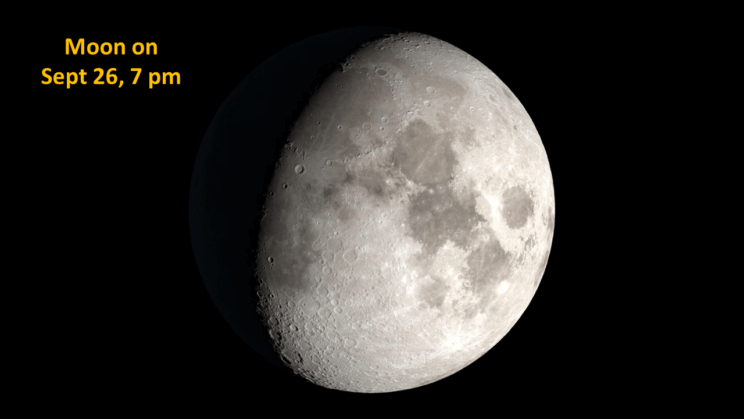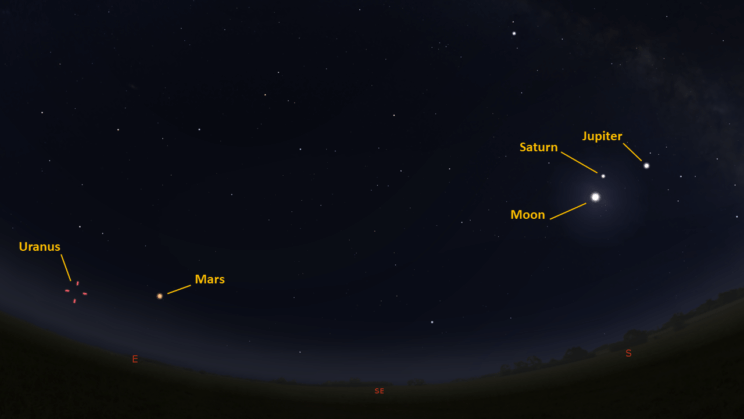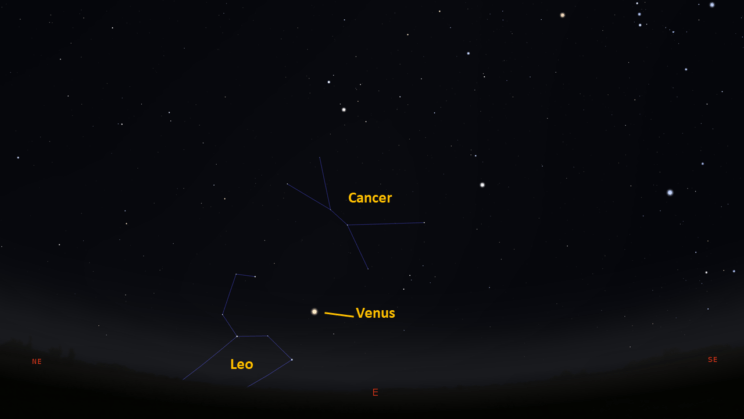This is the Saint Louis Science Center’s NIGHT SKY UPDATE for the week of Friday, September 25, 2020.
Information updated weekly or as needed.
Times given as local St. Louis time (CDT). For definitions of terminology used in the night sky update, click the highlighted text.
Public Telescope Viewings
Star parties at the Saint Louis Science Center have temporarily been canceled due to recommendations from the CDC regarding COVID-19. All public telescope events are canceled until further notice. As conditions change, we will reevaluate and update this article once public observing events resume.
Observing Highlight of the Week

Moon On September 26, 2020 at 7:00 pm
Credit: NASA, LRO, SVS, Ernie Wright
This week we will cover the Moon as there are several interesting lunar events this week. The major lunar event this week is International Observe the Moon Night. This event occurs annually bringing together lunar enthusiasts around the world to celebrate the Moon and lunar sciences. For 2020 the event occurs on September 26. For those interesting in observing the Moon on this night, you can create an image like the one above and add labels for visible features here. Click the picture once you are at the website. Also remember that the website linked above posts time in UT which we are 5 hours behind.
Also, this week the Moon will pass near the planets Saturn and Mars. On September 25, the Moon will reach conjunction with Saturn. Unfortunately, this occurs before we see the Moon rise in St. Louis. Once the Moon and Saturn are visible, the pair will still make a nice target for naked eye and binocular observations as they will be just over 4° apart. Later, on October 2, the Moon and Mars will be in conjunction. This occurs at 10:25 pm making it well place for views from St. Louis. At the time of conjunction, the Moon and Mars will be about 1° apart.
Lastly, on October 1, the Moon reaches full moon at 4:05 p.m. Full moon usually occurs once a month, but October will see two full moons. The moon phases are a lunar cycle called the synodic month. This cycle measures how long it takes the Moon to go from new moon to the next new moon, which is about 29.5 days. This is the basis for a calendar month but as our calendar is solar based, the length of a calendar month is averaged to 30 days. This results in a periodic occurrence of two full moons in a month. When this occurs the second full moon called a “Blue Moon”. October’s second full moon occurs on October 31.
The Sun and Moon

The Moon as seen from the International Space Station, on July 31, 2011.
Credit: NASA
Sunrise is at 6:52 a.m. on Friday, September 25 and sunset is at 6:52 p.m. providing us with 12 hours of daylight. Even after sunset, the light from the Sun will dimly illuminate our sky for about 1 hour and 30 minutes. This period is called twilight, which ends around 8:21 p.m. this week. For those with a sundial, local noon occurs around 12:52 p.m. this week.
| Day | Sunrise | Sunset |
|---|---|---|
| 2020-09-25 | 6:52 a.m. | 6:52 p.m. |
| 2020-09-26 | 6:53 a.m. | 6:51 p.m. |
| 2020-09-27 | 6:54 a.m. | 6:49 p.m. |
| 2020-09-28 | 6:55 a.m. | 6:48 p.m. |
| 2020-09-29 | 6:56 a.m. | 6:46 p.m. |
| 2020-09-30 | 6:57 a.m. | 6:45 p.m. |
| 2020-10-01 | 6:58 a.m. | 6:43 p.m. |
| 2020-10-02 | 6:58 a.m. | 6:41 p.m. |
| 2020-10-03 | 6:59 a.m. | 6:40 p.m. |
Moon
Moonrise for Friday, September 25 occurs at 3:53 p.m. and moonset will occur at 1:31 a.m. on the following day. On Friday, September 25 the Moon will exhibit a waxing gibbous phase with about 67% of the lunar disk illuminated. Full moon occurs on October 1 at 4:05 p.m.
International Observe the Moon Night
International Observe the Moon Night occurs this year on Saturday, September 26. On this day, the Moon will exhibit a waxing gibbous phase with 78% of the lunar disk illuminated. Lunar observers around the world will participate in celebrating and observing the most familiar object in the sky.
There are numerous ways to observe the Moon. Traditionally, we would encourage people to go out and look at the Moon. It is one of the best objects to see through binoculars or a telescope. If you do not have these instruments, no worries your eyes will work fine too. Aside from these methods NASA has put together a list of 10 ways to enjoy the Moon, you can find this list here. You can also learn more about International Observe the Moon Night here.
International Space Station (ISS) Observing

Visible passes of ISS from St. Louis for the week of September 25 occur during evening hours. The best pass this week occurs on October 3. Use the table below for information about this and other visible passes this week.
Catch ISS from St. Louis starting Friday, September 25
| Date | Starts | Max. altitude | Ends | |||||||
|---|---|---|---|---|---|---|---|---|---|---|
| Time | Alt. | Az. | Time | Alt. | Az. | Time | Alt. | Az. | ||
| 30 Sep | -0.8 | 21:03:51 | 10 | NNW | 21:04:31 | 14 | NNW | 21:04:31 | 14 | NNW |
| 01 Oct | -1.9 | 20:16:36 | 10 | NNW | 20:18:54 | 20 | NNE | 20:18:54 | 20 | NNE |
| 02 Oct | -1.6 | 19:29:24 | 10 | NNW | 19:31:33 | 16 | NNE | 19:33:20 | 11 | NE |
| 02 Oct | -0.9 | 21:05:25 | 10 | NW | 21:06:18 | 17 | NW | 21:06:18 | 17 | NW |
| 03 Oct | -3 | 20:18:00 | 10 | NW | 20:20:47 | 42 | N | 20:20:47 | 42 | N |
Magnitude (Mag): The Measure of brightness for a celestial object. The lower the value is, the brighter the object will be.
Altitude (Alt): The angle of a celestial object measured upwards from the observer’s horizon.
Azimuth (Az): The direction of a celestial object, measured clockwise from an observer’s location with north being 0°, east being 90°, south being 180° and west being 270°.
For information about ISS flyovers and other visible satellites, visit www.heavens-above.com
Detailed information regarding all unmanned exploration of our universe, missions past, present, and planned, can be found at Jet Propulsion Laboratories:
The Visible Planets

Looking Southeast, at 9:00 pm, September 25, 2020
Credit: Stellarium, EG

Looking East, 4:30 am, September 26, 2020
Credit: Stellarium, EG
This week, four naked eye planets are visible. Jupiter and Saturn rise before sunset. Look for them in the south once it is dark. Mars rises in the evening and will be best seen around midnight. Venus can be found in the eastern sky before sunrise.
For those tracking Jupiter and Saturn as they approach their great conjunction later this year, the two gas giants currently appear about 7.66° apart in the sky. From now until December 21, Jupiter will appear closer to Saturn each night.
Venus
Venus is well into another morning apparition. After months of seeing Venus in the west after sunset Venus is now visible in the east before sunrise. Venus rises at 3:29 a.m. and will be easily seen by 4:30 a.m. Venus remains a morning object until March 26, 2021 when it reaches superior conjunction. Since Venus has passed greatest western elongation, it will start to exhibit a gibbous phase.
Mars
The red planet rises around 8:01 p.m. and will be high enough to see in the east by 9:00 p.m. Opposition for Mars occurs on October 13, 2020. As we head towards this date Mars will appear brighter and larger through a telescope improving surface details. Surface features are already visible when viewing conditions are favorable. Current apparent brightness of Mars is -2.4 magnitude. At this magnitude Mars appears brighter than Jupiter.
Jupiter
Look for Jupiter in the southeast about 30 minutes after sunset. Jupiter will set at 12:40 a.m. Those with a telescope can enjoy views of Jupiter’s cloud features and the Great Red Spot when it is pointed towards Earth.
Saturn
Look for the ringed planet in the southeast about 30 minutes after sunset. Saturn sets at 1:18 a.m. For those with a telescope keep track of the orientation of Saturn’s rings. Since Saturn is tilted on its rotational axis, we cross the plane of Saturn’s ring every 13 to 15 years. We are headed towards another ring plane crossing on March 23, 2025. Over the next five years you will notice Saturn’s rings will gradually incline towards an edge on appearance.
Uranus
Uranus is not a planet we normally include in this section. Even at its dimmest, the giant planet does hover within naked eye visibility. That said, it is so close to the visible limit of the human eye it just is not reality for most of us to hope to see Uranus without the aid of binoculars or a telescope.
Like other planets, when at opposition, Uranus will appear brighter than it normally does. As we approach opposition with Uranus it will shift from a visual magnitude of 5.9 to 5.7. That extra bump in magnitude makes all the difference as it is now easy to see in binoculars. Uranus will reach opposition on October 31, so grab those binoculars and try to spot the 3rd largest planet in our solar system. You can find a finder chart for Uranus here
2020 Great Conjunction
This year the planets Jupiter and Saturn will reach conjunction. A conjunction is when two or more celestial bodies share the same right ascension. For Jupiter and Saturn this astronomical event occurs every 20 years. The conjunction occurs on December 21, 2020. You will find the two planets close together in the southwest just after sunset on this date.
Visit the James S. McDonnell Planetarium for more information on what’s up!
Night Sky Update: September 25-October 3, 2020






